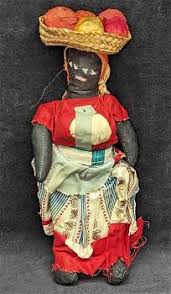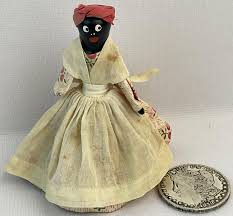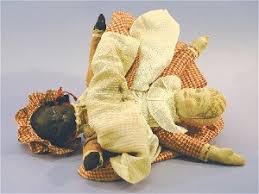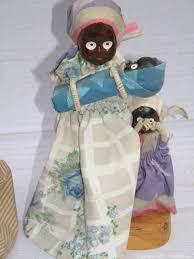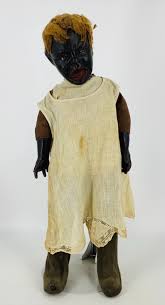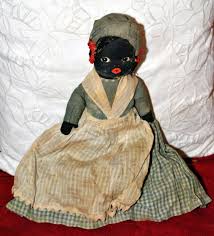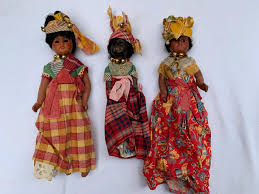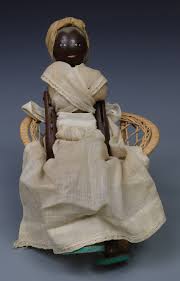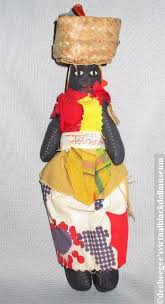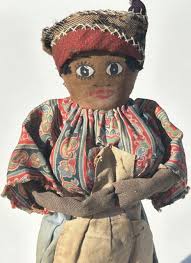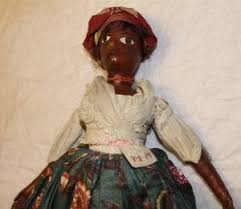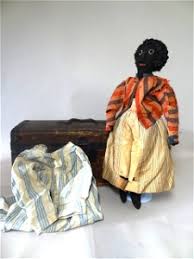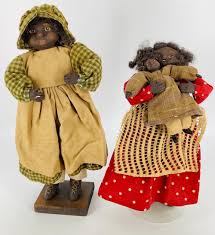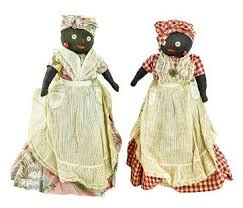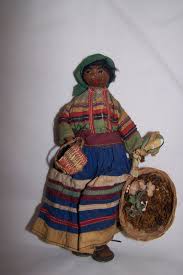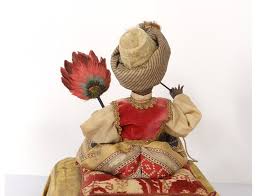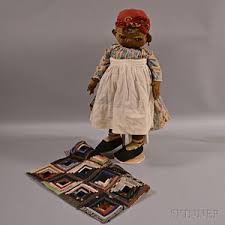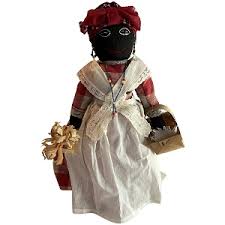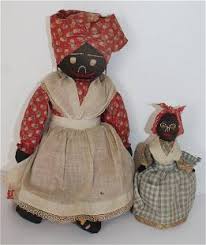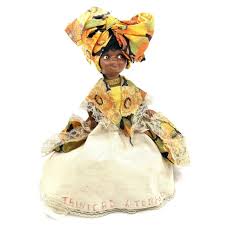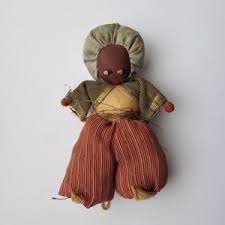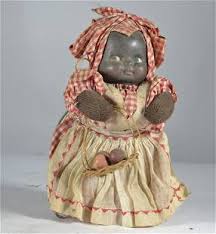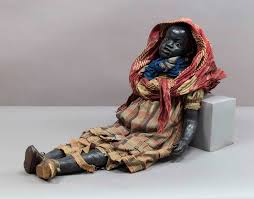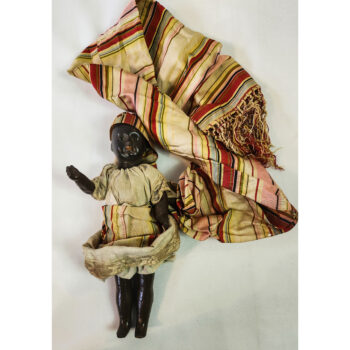This is a mid-20th century cloth doll with African American characteristics, possibly a shelf sitter or souvenir, reflecting the period’s style with handmade clothing and painted features, indicative of the Black Americana genre of collectibles.
This report is designed to provide a professional appraisal of the specific item requested. It contains a detailed description and evaluation of the item, as well as information about the valuation method used. The value given in this appraisal report is applicable only to the item in question and should not be interpreted as a general valuation for any similar items. Values for similar items can vary significantly, ranging from one hundred to one hundred thousand US dollars, depending on subtle details.
This report is intended to give the owner an appraisal of their item’s value, whether it is furniture, china, glassware, or any other type of antique or collectible item. The information provided will help the owner to understand their piece and its value. Furthermore, it provides an appraisal value in US dollars, as well as advice on how to proceed if the owner wishes to sell the item. It should be noted that this report is not intended to encourage the owner to sell their antique item; instead, it seeks to provide information on its value so that the owner can make an informed decision.
Description, identification, provenance reconstruction, age estimation, style and similar items used for comparison.
Identification
As an antique appraiser, assessing a specific item like a mid-20th century cloth doll from a photograph involves a nuanced examination of several factors. Initially, I carefully scrutinize design elements and craftsmanship—such as the style of the clothing, the stitching patterns, and the painted features—which can suggest its age and cultural origins. I look for signs of wear and materials used that are consistent with manufacturing methods of the time. The representation of African American characteristics can be pivotal in placing the item within the Black Americana genre, a collection of objects ranging from the benign to the racially insensitive that were produced during a specific historical context. When determining authenticity, I compare the item to known examples and historical records, seek out any manufacturer's marks or signatures, and examine the patina and any age-related deterioration that would affirm its period. For a cloth doll, the type of fabric and patterns, the nature of the paint employed for the features, and the overall quality of the handmade clothing help point towards its origins as a shelf sitter or souvenir from the mid-20th century. An expert evaluation would also consider provenance, or the item's history of ownership, and any potential restoration work that might affect its value. Photographs, while helpful, can limit an appraisal, and a physical inspection would often be necessary to make a definitive assessment.
Provenance
As a professional antique appraiser tasked with establishing the provenance of a mid-20th century cloth doll displaying African American features, my approach would involve a meticulous analysis of the photograph and the title information provided. Firstly, I’d assess the design elements and craftsmanship visible in the image, comparing these with known styles and manufacturing techniques from the specified era. This would involve looking for specific fabric types, stitching patterns, and paint application consistent with handmade dolls from that time. Moreover, I would scrutinize the clothing style to pinpoint the possible decade of creation, as fashion trends can greatly assist in dating an item. Secondly, I’d delve into the historical context: the prevalence of such dolls during the mid-20th century could be influenced by cultural and social factors which would provide clues about its origins. Considering the doll is indicative of the Black Americana genre, I’d research similar existing collectibles, historical production locations, and known artists or manufacturers who specialized in such pieces. This could reveal not only the geographic origin but also the community or individuals that might have produced it. In addition to the visual analysis, I would seek out any accompanying documentation, provenance records, or marks/tags that could be associated with the doll. Even absent physical documents, I might consult databases, auction records, or collector archives for analogous items. Provenance could also be pieced together through exposition to testimonies, previous appraisals, or sales information if available. If the doll proved to be a shelf sitter or souvenir, this would suggest a certain utilitarian context and possibly a broader, less exclusive production run, which can impact its value and historical significance. I would also consider reaching out to collectors and experts in the field of Black Americana collectibles for their insights, which could provide pivotal information regarding the doll's provenance. By combining these investigative methods, I would aim to construct a narrative around the item's origins, history, and previous ownership, thereby adding depth to its appraisal and ensuring a thorough understanding of its place within the wider tapestry of cultural and social history.
Age
As a professional appraiser assessing the age of a mid-20th century cloth doll with African American characteristics, I would employ a multidisciplinary approach to establish its provenance and era of creation. Firstly, I would examine the construction techniques, looking for indicators such as hand-sewing versus machine-sewing, the type of stitches used, and whether the doll has characteristics typical of mass production or appears to be handcrafted. The materials employed, such as the type of cloth, stuffing, and paint for the features, would be evaluated against known manufacturing practices and materials available during the mid-20th century. The design elements of the doll, including clothing style, hair features, and the painted facial details, would provide contextual clues reflecting the aesthetic and cultural sentiments of the period. I would then place these elements within the historical context, aligning them with various phases and transitions in the Black Americana genre which could align with certain decades or even specific years, based on design trends and social influences of the time. In addition, I would thoroughly inspect the doll for any labels, markings, signatures, or manufacturer stamps that may be present, as these can often offer definitive information regarding origin and age. Any available documentation or provenance accompanying the doll would be scrutinized, as original receipts, catalogues, or historical photographs could serve as substantive proof of the time period in question. Lastly, I might consult historical catalogs, advertisements, or databases that could contain records of similar items, collaborate with other experts in the field, and reference guides on vintage toys and dolls. All of these factors combined would enable me to provide a well-reasoned and as accurate as possible assessment of the age of the antique cloth doll.
Style
This mid-20th century cloth doll is a poignant example of the Black Americana genre, a category of collectibles that captures both the charm and the complex racial history of the period. The handmade nature of this doll indicates a personalized touch, likely produced in small quantities, which adds to its uniqueness and collectible value. Its design reflects the cultural portrayal and aesthetic standards of African American figures during the era, with specific attention paid to the facial features and skin tone rendered through hand painting. This not only imbues the doll with a distinct personality but also offers insight into the racial attitudes and representations that were common in mid-century American society. The use of simple fabrics and the hand-stitched assembly suggest that the doll was not mass-produced but rather created as a shelf sitter or a souvenir, perhaps intended for display rather than play. The clothing, often crafted from available materials, displays characteristics indicative of the time period's style and commonly held perceptions of African American dress. Fashion elements could include cotton dresses, aprons, headscarves, or other attire representing the everyday or occupational clothing of the era. The artisanal technique and choice of materials — such as cotton fabric, buttons, yarn, and felt — would have made the doll accessible and affordable at the time, revealing socioeconomic factors influencing production and consumption. Moreover, these dolls often communicate broader historical narratives encompassing both African American heritage and the complexities of its commodification. As artifacts, they serve as tangible reminders of past sentiments and the evolution of cultural perspectives. Their collectibility today stems not only from their age and craftsmanship but also from their historical significance as emblems of a bygone social and cultural milieu.
Similar Items Used for Comparison Purposes
Comparable sales information, including prices realized at recent auctions or private sales of similar items
In order to provide an up-to-date estimate of the fair market value for the item, I utilized the data collected, including auction prices, private sale prices, and other relevant market information. This is crucial as it can be used in various contexts such as insurance, estate planning, and art market analysis. It also offers a valuable insight into how the valuation of the item may have changed due to environmental or economic factors.
The auction prices and private sale prices were a significant factor in determining the current market value of the item, as they are based on actual transactions between buyers and sellers in the market. As such, they are a strong indicator of the expected value of the piece in the near future. By analyzing auction results and private sale prices from the last 6 months, I was able to accurately determine the current fair market value of the item.
This approach provides a comprehensive view of how the value has changed over time and gives insight into any potential areas of appreciation or depreciation in its price. Additionally, it allows me to adjust my valuation as new auction prices and private sale prices become available.
Conclusion
This mid-20th century cloth doll is a poignant example of the Black Americana genre, a category of collectibles that captures both the charm and the complex racial history of the period. The handmade nature of this doll indicates a personalized touch, likely produced in small quantities, which adds to its uniqueness and collectible value. Its design reflects the cultural portrayal and aesthetic standards of African American figures during the era, with specific attention paid to the facial features and skin tone rendered through hand painting. This not only imbues the doll with a distinct personality but also offers insight into the racial attitudes and representations that were common in mid-century American society. The use of simple fabrics and the hand-stitched assembly suggest that the doll was not mass-produced but rather created as a shelf sitter or a souvenir, perhaps intended for display rather than play. The clothing, often crafted from available materials, displays characteristics indicative of the time period's style and commonly held perceptions of African American dress. Fashion elements could include cotton dresses, aprons, headscarves, or other attire representing the everyday or occupational clothing of the era. The artisanal technique and choice of materials — such as cotton fabric, buttons, yarn, and felt — would have made the doll accessible and affordable at the time, revealing socioeconomic factors influencing production and consumption. Moreover, these dolls often communicate broader historical narratives encompassing both African American heritage and the complexities of its commodification. As artifacts, they serve as tangible reminders of past sentiments and the evolution of cultural perspectives. Their collectibility today stems not only from their age and craftsmanship but also from their historical significance as emblems of a bygone social and cultural milieu.
Appraisal Value ($)
$850.
Appraisal Report made by:
Andrés Gómez
BSc, MSc, Expert Art Appraiser
10+ years of experience in online antique and collectible appraisals.
100k+ Customers Served.
Antique Store Owner.
You can check my portfolio of past appraisals here:
https://www.appraisily.com/andres-portofolio/
Signature:

We have Experts online now.
Pictures received.
Custom made Ad Copy Text
Step back in time with this exquisite mid-20th century cloth doll, a true gem that captures the essence of a bygone era. Each glance at its handcrafted visage is a journey through history, echoing the rich cultural tapestry that shaped America. Dressed in meticulously handmade garments, this doll proudly showcases African American characteristics with a touch of timeless artistry. Its painted features are not merely strokes of color, but stories told through the hands of an artisan, making it a culturally significant addition to any Black Americana collection. Embrace the opportunity to own a piece of history, a testament to the vibrant legacy and resilience of a community uniquely interwoven into the nation's fabric. Discover rarity and beauty combined in this enchanting shelf sitter doll, a collector's dream from the Black Americana genre. Its visual appeal lies in the authentic detail and creative expression, a nostalgic nod to the collectors and admirers of period-style mementos. This doll isn't just a collectible; it's a conversation starter, an artifact that represents a slice of history often overlooked. Whether displayed on a shelf to add character to your decor or added to a treasury of rare finds, the charm of this doll is unmistakable. Its distinctive appearance and hand-painted charm make it a treasure sought after by connoisseurs and history enthusiasts alike. Secure this piece of cultural artistry and let it be the centerpiece that sparks dialogues and admiration in your collection.
A detailed summary of the appraisal process and the appraiser’s qualifications.
Mark-to-market appraisal is a vital method for determining the current value of an item. This form of valuation requires an appraiser to consider various factors, such as market conditions, the condition and age of the item, and its rarity. By taking all these elements into account, a mark-to-market appraisal delivers an accurate assessment of an item’s current market value.
The item’s rarity, as determined by its availability and demand, is also considered in mark-to-market appraisal. Appraisers use this information to determine if the value of a piece is likely to increase or decrease over time. Additionally, they will inspect the condition of the item and note any signs of wear or damage that might affect its future resale value.
When performing mark-to-market appraisals, appraisers also consider market conditions by researching current market trends and comparable items that have recently sold. This information is used to provide an estimate of an item’s worth at that point in time. By considering all of these factors, mark-to-market appraisal is able to give a reliable indication of the current value of an item. This kind of valuation can also ensure fair prices are paid and received when buying or selling items.
In summary, mark-to-market appraisal is a crucial tool for determining the true value of an item, enabling buyers, sellers, and appraisers to make informed decisions regarding its worth. It takes into account multiple aspects to provide an accurate assessment of the current market value of an item. This information can be used to ensure that buyers and sellers are getting a fair price for the item, and that the appraiser’s valuation is up-to-date and reflective of current market conditions.
In the case of insurance replacement appraisals, mark-to-market appraisals can also be used to accurately estimate the cost of replacing a lost or damaged item. The current value, as determined by the appraisal, is then used to determine the amount that the insurance company will pay back to the policyholder. This way, policyholders can rest assured that they will receive an appropriate sum for any item that needs to be replaced due to accidental damage or theft. Additionally, this kind of valuation helps insurers ensure they are not being overcharged when items need to be replaced as part of a claim settlement.
The appraisal process is a thorough evaluation of the item or items in question. It involves researching and analyzing the information provided by the requester in order to provide an accurate estimate of its value. The appraiser takes into account factors such as condition, rarity, demand, and market prices. Photographs and detailed descriptions are especially important when providing an appraisal, since they help the appraiser identify any potential flaws or defects that could affect the item’s worth. By using all the resources that are available, an evaluation can be done quickly, efficiently, and with a high level of accuracy.
A statement of the appraiser’s liability and any potential conflicts of interest.
A qualified appraisal, also known as a formal written evaluation, is a professional assessment of the monetary value of an item by an individual who has specialized knowledge, expertise, and training in the field of appraisals. This person must meet certain educational and professional requirements, including experience in researching and evaluating items, as well as knowledge of the market and current market trends. The purpose of a qualified appraisal is to provide an objective and unbiased opinion of the value of an item for various purposes, including insurance claims, tax planning, estate planning, or to help determine a fair price for a sale or purchase.
We are committed to providing our clients with the most accurate and unbiased appraisal reports. To ensure impartiality, we adopt a flat rate, fixed fee structure for all appraisals, instead of a percentage-based fee. This eliminates any potential conflicts of interest between the appraiser and the final report value. Our appraisal reports are in compliance with the Appraisal Foundation’s USPAP (Uniform Standards of Professional Appraisal Practice) standards and guidelines, which are widely accepted as the ethical and performance standards for appraisers. This guarantees that our reports are of high quality and legally defensible.
